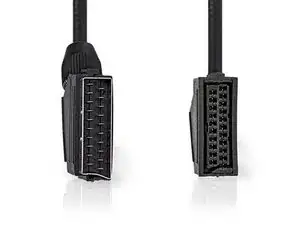
Background
SCART (also known as Péritel or Péritélévision, especially in France, 21-pin EuroSCART in marketing by Sharp in Asia, Euroconector in Spain, EuroAV or EXT, or EIA Multiport in the United States, as an EIA interface) is a French standard for analog audio and video interconnects. It was introduced in 1978 as a way to simplify the connection of various audiovisual devices, such as TVs, VCRs, and DVD players. The SCART connector allows for the transmission of both composite and RGB video signals, as well as stereo audio signals.
The name SCART comes from Syndicat des Constructeurs d'Appareils Radiorécepteurs et Téléviseurs, "Radio and Television Receiver Manufacturers' Association", the French organisation that created the connector in the mid-1970s.
Identification
SCART cables have a rectangular 21-pin connector on each end, with a notch on one side to ensure proper orientation. The connector is typically black, with the pins arranged in three rows. The connector is typically found on the back of these devices and is plugged into a corresponding port on the other device.
SCART cables support both standard definition (SD) and high definition (HD) video signals, as well as stereo audio signals. They can also carry other types of signals such as RGB, composite, and S-video. SCART cables have largely been replaced by newer digital interfaces such as HDMI, but they are still commonly found in older equipment as it can provide good quality analog signals.
